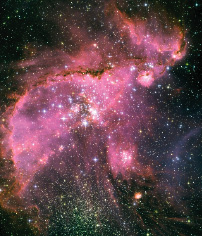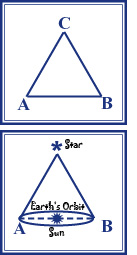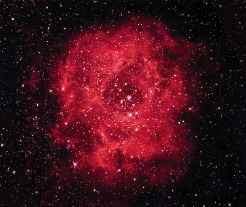

 objects are just a
small part of a vast belt of objects orbiting the Sun. We are
able to watch stars explode and galaxies change in places we can
measure to be millions of light years away. In our own galaxy we
continue to watch the aftermath of Supernova 1987A, a star that we
watched explode in 1987 and which is 160,000 light years away from us.
objects are just a
small part of a vast belt of objects orbiting the Sun. We are
able to watch stars explode and galaxies change in places we can
measure to be millions of light years away. In our own galaxy we
continue to watch the aftermath of Supernova 1987A, a star that we
watched explode in 1987 and which is 160,000 light years away from us.
There are many ways that people deal with these new discoveries, and many ways that people explain away the huge distances and sizes that are a part of them. Some people simply deny the evidence. The position of these folks is that it cannot be true because they have a belief system that does not allow it to be true. The data and the reports are viewed as either a clever plot to destroy their belief system by distorting information or a lie perpetuated by dishonest people.
Another view held by some religious people is what is called "The Belly Button Syndrome." This view is that God has faked the whole thing, and what we are seeing and measuring has been created as a great illusion by God. In our September/October 2006 issue of this journal, Al Maxey showed why such a position is logically impossible on a biblical basis but it remains a position that many people accept.
A third approach is to invent a scientific explanation that attempts to explain how these huge sizes and distances are not what they appear. Gerald Shroeder, for example, has used relativity to explain away these sizes. There are those who have maintained that the speed of light has changed and continues to change attempting to explain away the sizes. There have also been those who maintain that the shape of space is so curved that what we are looking at are loops in the curvature of space/time and that the cosmos is in reality very small. The analogy would be that if you walked around the earth at the equator you could walk forever making repeated traverses around the circumference of the earth.
The fact of the matter is that all of these attempts to explain away the size of the cosmos are at odds with the evidence. It is also a fact that most young people have had classes in what we will be describing in this article and know that the explanations that we have described so far are incorrect and in fact impossible.
Methods of Measuring Distance in Space
It is important to understand that there are many reliable methods of making measurements in space, and that they all show us that the size of space is very large. Most of us know something about trigonometry--even if we have never taken a course in it. This is a part of mathematics that allows distances to be measured using triangles. If you can measure the distance between two points, and can measure the angle to a third point from each of them, you can calculate how far away the third point is. In the diagram on the next page, let us suppose that points A and B are known and the distance between them is known. What we want to know is how far away point C is. From point A you measure the angle from B to C. From point B you measure the angle from A to C. There are simple formulas in trigonometry that allow you from this information to calculate the distance of either A or B to C. This mathematics is used to survey in real estate and to calculate and build huge structures like bridges and skyscrapers.
 Now look at the
next drawing. Here we have the earth orbiting the sun. We want to
know how far away the star is from the earth. The way we do this
is to measure the angle from the sun to the star when the earth is at
point A, and then measure the angle from the sun to the star when the
earth is at point B. We know how far we are from the sun so we
know the base of the triangle. Doing the same mathematics as
above, we can calculate how far away from us the star is.
Now look at the
next drawing. Here we have the earth orbiting the sun. We want to
know how far away the star is from the earth. The way we do this
is to measure the angle from the sun to the star when the earth is at
point A, and then measure the angle from the sun to the star when the
earth is at point B. We know how far we are from the sun so we
know the base of the triangle. Doing the same mathematics as
above, we can calculate how far away from us the star is.
This method of measuring distances in space is very accurate and very reliable. The only problem we have is that if the object is very, very far away, the angle between the sun and the object gets to be so close to 90 degrees that we cannot measure it. That means other methods have to be used.
Another method of measuring distances in space involves measuring
the brightness of something and how it changes with distance. If
you see a car coming toward you and if the lights are very bright you
know the car is close to you. If it is very far away the
headlights will not be very bright. In physics we have an
equation which describes this. It simply says that the brightness
is equal to how strong the light is divided by the distance the light
is away from us squared (E=I/x2).
If you take a 100 watt light bulb and place it 5 meters  from
you, the brightness would be 100 watts divided by 5 squared or 4.
Conversely, if the brightness was 4 and you know the bulb is 100 then
it must be 5 meters away (100 divided by 4 and then take the square
root.) (Adults, if you are having trouble with this have your
sixth grader explain it to you, because this is part of the modern
sixth-grade math curriculum).
from
you, the brightness would be 100 watts divided by 5 squared or 4.
Conversely, if the brightness was 4 and you know the bulb is 100 then
it must be 5 meters away (100 divided by 4 and then take the square
root.) (Adults, if you are having trouble with this have your
sixth grader explain it to you, because this is part of the modern
sixth-grade math curriculum).
There is a special kind of star we see all around us in space that is called a Cepheid variable star. These stars pulse or flicker. The faster they flicker the brighter they are. That means that if we measure their flicker, no matter where they are, we know their brightness. We see these Cepheid variable stars in other galaxies, and we can measure their brightness as seen here on Earth. Using the simple mathematics above, we can calculate how far away the galaxies are.
 A third method of
measurements in space is called interstellar reddening. When a
bright light is close to you, the higher energies of blue and violet
will get to your eye and you will see them. The further away you
get, the more these higher energies are refracted and scattered away
from you. When the blue and violet energies are taken out of the
light, the light will appear to be red. This is called
reddening. When the sun is right overhead and its rays come right
straight at us, it is very white and bright. At sunset or sunrise
when the distance has changed and the light rays have to go through
more air to get to us the sky gets red. As we look out in space,
we see some objects that are very red indicating that the light has
come a great distance through a lot of debris in space. This can
be used to estimate how far away something is in space.
A third method of
measurements in space is called interstellar reddening. When a
bright light is close to you, the higher energies of blue and violet
will get to your eye and you will see them. The further away you
get, the more these higher energies are refracted and scattered away
from you. When the blue and violet energies are taken out of the
light, the light will appear to be red. This is called
reddening. When the sun is right overhead and its rays come right
straight at us, it is very white and bright. At sunset or sunrise
when the distance has changed and the light rays have to go through
more air to get to us the sky gets red. As we look out in space,
we see some objects that are very red indicating that the light has
come a great distance through a lot of debris in space. This can
be used to estimate how far away something is in space.
A fourth method of measuring distances in space relies upon the fact
that exhaustive measurements have been taken of galactic speeds in
space. We can measure the speed of something in space by the
shift in the colors of the light it sends out. If you are
standing by a railroad track and a train comes by with its horn
blowing, you hear the pitch of the horn drop as it goes by. Race
cars also give us that drop in the pitch of their engines as they pass
us in a race.  There is a formula
used by the police for catching speeders that allows the speed of the
car to be calculated. This is used in race cars, studies of
trains, and the motion of things in space. The further out in
space things are, the faster we measure their speed to be going.
If a race car goes by you and you do not hear the drop in pitch, how
fast was it going? If you hear a huge drop in pitch, what do you
know? Measuring the speed of a galaxy in space tells us how far
away it is according to an equation known as Hubble's Law which says
the speed is equal to a constant known as Hubble's constant multiplied
by the distance from Earth the object is located.
There is a formula
used by the police for catching speeders that allows the speed of the
car to be calculated. This is used in race cars, studies of
trains, and the motion of things in space. The further out in
space things are, the faster we measure their speed to be going.
If a race car goes by you and you do not hear the drop in pitch, how
fast was it going? If you hear a huge drop in pitch, what do you
know? Measuring the speed of a galaxy in space tells us how far
away it is according to an equation known as Hubble's Law which says
the speed is equal to a constant known as Hubble's constant multiplied
by the distance from Earth the object is located.
We have given you these simplified explanations of how measurements in space are done to help you understand how good these methods are. Young people learn about these methods in physics, earth science, math, and physical science classes. The mechanics of how specific numbers are generated can be complex, but the basic concept of these methods are very simple and easy to understand.
Attempts to Deny These Measurements Do Not Work
There are religious groups and pseudoscientific groups that have
tried to find ways around these measurements. Suggesting that
the speed of light is changing and that this change invalidates these
measurements for example, is not a good response to these
measurements. In the first place the speed of light is easy to
measure and measurements from the time of Michelson and Morey in the
nineteenth century to now do not show the speed of light to be
changing--especially enough to invalidate distance measurements in
space. Trying to suggest that the cosmos was moving close to the
speed of light and that, as it has slowed down, all of these measuring
devices changed does not work well either. Changes in speed do
not just affect time. They also effect mass, and if things were
traveling close to the speed of light when the creation was first
completed the masses of everything would have been so huge that  the whole system would have collapsed into a gigantic
black hole. There are many huge factual problems with this
explanation.
the whole system would have collapsed into a gigantic
black hole. There are many huge factual problems with this
explanation.
Suggestions that the cosmos is curved so sharply that all of the measuring devices are in error is something not supported by the evidence. If the cosmos was curved so sharply, then light rays would not travel parallel to one another and would not allow distances to stay constant in space. All measurements show that unless there are massive gravitational anomalies in the area, light rays do travel in essentially parallel rays. The basic curvature of space is so small that our current measuring devices cannot detect any curvature at all. In short, all attempts to deny the massive size of the cosmos and the distances involved in the cosmos fail every observational and scientific test that can be applied to them. Andromeda is in fact two million light years away from the earth, and Supernova 1987A is in fact 160,000 light years from us in our own galaxy. That means the light from this explosion that we have watched happened, left there 160,000 years ago.
Making Apologetic Sense of These Distances
Why is the cosmos so big? How do these distances relate to the biblical account. The answers to these questions reside in three basic problems many people have: (1) Their God is too small, (2) God's purposes are too large, and (3) Human tradition is too short-sighted.
Many atheists and believers alike have a concept of God that is inconsistent with a large cosmos or a spiritual existence. If you understand God to be a human with human physical attributes and limitations, then any suggestion that the cosmos is massive in size is unacceptable. God created time, space, and energy. The statement of Genesis 1:1 that there was a beginning maintains that time, space, and energy came into existence by a process that is not physical. Every description of God and of that process in the Bible indicates that God functions differently than we do. Quantum mechanics supports this notion and says that the laws of very small things like atoms and quarks are different than the laws of the physical world in which we live. Both atheists and believers have been guilty of creating a god in their own image, and this makes the concept of massive distances and sizes difficult to grasp.
The purposes of God are spelled out in the Bible in passages like Ephesians 3:9-10; 6:12 and Job 1 and 2. The struggle between good and evil and the agencies involved in this struggle reach beyond our physical existence. Is this struggle being carried on elsewhere in the physical cosmos? If it is, we will never know it in this life, because the distances are so huge that no contact is possible between us and them. That in fact may be the reason for the massive distances in space, but we will never know it in this life. The majesty and power of God are attested to in the magnificence of His creation. In our own lives and on our own planet we can see the terrible war between good and evil being played out. Denying that it could be taking place elsewhere is going beyond what mankind can know, but the evidence is certainly that the size of the cosmos can accommodate such a reality.
Human tradition wants to trivialize God and his purposes. Atheists want to make God a nonfactor, and maintain that all there is to our existence is what we can see and experience in the physical. The problem with this is that it ends up having to deny the existence of good and evil (see Richard Dawkin's statement in Out of Eden, page 133), and puts our entire moral code on the basis of survival of the fittest. Many creationist go to the other extreme, making our existence so unreal that common sense and clear observations have to be denied to maintain a human theology. The Bible avoids both of these pitfalls, describing man's existence in very real terms and in such a way that the facts we observe in the cosmos fit all we experience and understand.
The Does
God Exist? program offers free courses and materials to allow
you to explore the magnificence of not only the cosmos in which we
live, but in the spiritual journey which we experience as well.
Look at the evidence and it will give you powerful reasons to believe
in God, powerful evidence to accept the Bible as His word when it is
taken literally (not traditionally), and the power to find meaning and
purpose in life that brings fulfillment and value to all you are and
all you experience. "'To whom will you compare me? Or who is my
equal?' says the Holy One. Lift your eyes and look to the
heavens: Who created all these?" (Isaiah
40:25-26.)
Back to Contents Does God Exist?, JanFeb08.